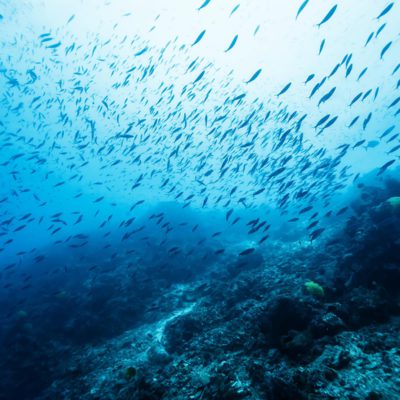About herring
A herring’s life
The herring or “Clupea harengus” is a ray-finned fish that occurs mainly in the northern hemisphere. The herring lives in schools of millions of fish and one school can be up to 100 metres high. In the North Sea, there are around 50 billion herring swimming around every year.
Herring feed on plankton and the smallest sea creatures. After two to three years, a herring is mature and about 20 cm long. A herring can grow up to 40 cm long and about 8-10 years old.
In adulthood, the herring is ripe for spawning and the fish goes through its annual cycle. In the autumn, the male and female calves develop homogenous growths. In December, the females deposit the spawn in the sea and the males fertilise them. One female herring can produce more than 100,000 eggs per year.
After pawning, the herring is very lean, but this will change in the spring. In the spring the number of plankton increases and with sufficient plankton a herring can become 2% fatter every day.



Herring as “maagdje”
Every year, 30 million kilos of herring are processed into matjes. Matjes-herring is the herring caught between May 1st and August 31st. During this period, the herring has already accumulated the necessary fat, at least 16%, but has not yet spawned. The name ‘matje’ is, therefore, a corruption of ‘maagdje’, literally meaning ‘virgin’. The fish is still ‘maagdelijk’ (or ‘virgin’ in English) because the herring have not yet reproduced. Matjes-herring is available all year round.
What we call ‘maatjes’ (so matjes-herring or young herring) in Belgium, our northern neighbours describe as ‘Hollandse Nieuwe’ (literally: Dutch new ones’). This has nothing to do with the nationality of the fishermen who landed the fish or the place where it was fished, but it does concern the processing process on land. ‘Hollandse Nieuwe’ stands for the traditional method of production: gutted, headed, pickled or dry salted and natural enzymatic ripening. The Hollandse Nieuwe means that the matjes-herring were caught and sold in the period from May 1st to August 31st.

The processing of herring
Herring is almost entirely salted and frozen. Because the pancreas remains in place, this gland can produce an enzyme that triggers the maturation process. This maturation gives the herring its typical taste, odour and texture.
Brining is done in a saline solution using seawater with extra salt. The salt content is determined by the size of the fish, the fat content and the temperature of the fish. Subsequently, the soused herring goes into the freezer.
Frozen herring can be stored for months, allowing us to eat matjes-herring (or young herring) all year round. Due to the extremely slow maturing process in the freezers, the taste is often somewhat fuller.
The less fatty herring caught off-season is processed in a different way.
- Herring fillets: filleted and marinated herring preserved in vinegar.
- Rollmops: rolled up marinated herring with skin, filled with onion and preserved in vinegar.
- Pan herring: baked herring, subsequently preserved in vinegar.
- Baked herring: lightly smoked, deep-fried herring.
- Bokking: hot or cold smoked herring.
- Kipper: unfolded smoked herring, which is smoked both hot and cold.
Gilco is specialized in the processing of herring for years. Click here for more information about the production process.


Herring and health
Herring is a healthy fatty fish. Scientific studies have shown that people who regularly eat oily fish are approximately 50% less likely to suffer from cardiovascular disease.
Herring contains high-quality proteins and the fat of the herring consists, for a large part, of unsaturated omega-3 fatty acids. Omega-3 fatty acids have been attributed to numerous beneficial influences, such as reducing the risk of cardiovascular disease and having a beneficial effect on the brain and the nervous system. The saying, ‘Haring in het land, dokter aan de kant’ (freely translated ‘herring in the land, the doctor at a stand’) speaks for itself.
The advantage of herring compared to other fatty fish is that you eat herring cold, which means that the fish fatty acids are undamaged. Omega-3 fatty acids are unstable and oxidise rapidly when heated or exposed to the air for a long time. That is also the disadvantage of fish oil supplements.
Herring also contains a lot of calcium, magnesium and phosphorus – important nutrients your body needs to produce hydroxyapatite, the mineral that provides healthy teeth and bones. The proteins in herring are also important for the production of strong bones because your body uses the proteins from the diet to build and repair body cells.
On average, herring contains 16 grams of fat and 18 grams of protein per 100 grams. The fat content depends on the time of capture. Under favourable conditions, a herring can become 2% fattier every day in the spring. Ultimately, a quarter of its weight can consist of fat.
